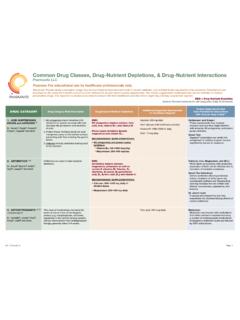Transcription of INTRODUCTION TO BOTANY - Home Science Tools
1 9 INTRODUCTION TOBOTANYTHIS IS A PREVIEW. THE NUMBER OF PAGES DISPLAYED IS TABLE OF CONTENTSTEXTBOOK LESSON 1 LAB SUPPLY LISTJUNIOR NOTEBOOKING JOURNAL SAMPLEREGULAR NOTEBOOKING JOURNAL SAMPLEFREQUENTLY ASKED QUESTIONSvINTRODUCTION TO BOTANY .. 9 LESSON 1: WHY BOTANY MATTERS? ..13 Welcome ..14 Creative Creator ..16 Nature Journaling ..17 Activity : Think Like a Scientist ..18 Activity : Make a Nature Journal ..19 Using Your Nature Journal Like a Scientist ..19 Activity : Journal About Nature ..21 Science of BOTANY ..21 Activity : Observe Leaf Veins ..25 Activity : Observing Absorption ..25 Activity : Walking Water Without a Vascular System ..26 Activity : Go on a Nature Hunt ..27To Seed or Not to Seed ..27 Seedless Plants ..28 What Do You Remember? ..28 Activity : Grouping Plants ..29 Activity : Make a Light Hut ..29 Activity : Grow Edible Plants ..30 LESSON 2:SEEDS ..31 Sleeping Seeds ..32 Testae.
2 33 Activity : Design a Seed ..34 Activity : Examine Your of A Seed ..35 Activity : Identify Dicots and ..38 What Do You Remember ..39 Activity : Label the Parts of a Seed ..39 Activity : Compare Germination Conditions ..40 LESSON 3: ANGIOSPERMS ..43 Flowering Plants ..44 Activity : Disect a Flower ..46 Activity : Label a Flower ..49 Activity : Walk in Nature ..49 Flower Families ..50 Activity : Plant a Sunflower ..51 Think About This ..53 Activity : Label an Orchid ..54 Flesh Eating Flowers ..55 What Do You Remember? ..58 Activity : Design a : Preserve a Fresh Flower ..59 LESSON 4: POLLINATION ..61 Pollination ..62 Think About This ..63 Bees ..63 Other Insects ..67 Activity : Explore Flower Pollination ..68 Bird Pollinators ..68 Activity : Build a Hummingbird Feeder ..69 Mammal Pollinators ..70 Activity : Illustrate Animal Pollinators ..71 Wind Pollination ..71 Why Most Flowers Don t Self-Pollinate.
3 72 Self-Pollination ..73 The Pollinated Flower ..73 What Do You Remember? ..74 Activity : Illustrate What You Learned ..74 Activity : Create a Comic : Make a Butterfly Garden ..75 MoTABLE OF CONTENTSviLESSON 5: FRUIT ..77A Flower s Fruit ..78 Fruits and Kinds ..79 Activity : Observe Insects on a Banana ..80 Activity : Catagorize Fleshy Fruits ..81 Activity : Split a Squash ..82 Think About This ..82 Dry Fruits ..83 Activity : Find and Illustrate Fruits ..84 Seed Scattering ..85 Activity : Examine Burrs ..88 What Do You Remember? ..91 Activity : Discribe Seed Dispersal ..91 Activity : Preserve the Color of Fruit ..92 LESSON 6: LEAVES ..93 Leaf Mouths ..94 Making Food ..96 Photosynthesis ..97 Sunshine Energy ..97 Activity : Burn a Candle in a Jar ..98 Color-Fill ..98 Activity : Block the Sun ..99 Activity : Sprout Potatoes ..100 Transpiration ..100 Activity : Test Transpiration ..101 Falling Leaves ..102 Activity Preserve Leaf Color.
4 103 Anatomy of a Leaf ..103 Simple Leaves and Compound Leaves ..104 Leaf Arrangement ..104 Leaf Venation ..104 Leaf Shapes ..105 Leaf Margins ..107 What Do You Remember ..107 Activity Illustrate the Anatomy of a Leaf ..107 Activity Make a Leaf Storybook ..108 Activity Collect Leaves ..108 LESSON 7: ROOTS ..109 Good Soil ..110 Nutritious Soil ..111 Activity : Make a Quick Compost ..112 Root Hairs ..114 Root Growth ..114 Preventing Erosion ..115 Floating Roots ..116 Geotropism ..116 Activity : Discover Geotropism ..117 Root Systems ..118 Geophytes ..118 Rooting ..119 What Do You Remember? ..120 Activity : Illustrate Roots ..120 Activity : Classify Roots ..121 Activity : Clone Vegetables Through Rooting ..121 LESSON 8: STEMS ..123 Plant Structure ..124 Activity : Explore Xylem ..125 Woody and Herbaceous Stems ..126 Activity : Draw Woody and Herbaceous Stemmed Plants ..127 Succulent Plants ..128 Auxins.
5 128 Activity : Imitate Phototropism ..129 Examples of Phototropism ..129 What Do You Remember? ..130 Activity : Color a Flower ..130 Activity : See Auxins in Action ..131viiLESSON 9: GARDENING ..133 Your Edible Garden ..134 Gardening Power ..134 Better Foods ..135 Activity : Create a Garden Journal ..136 Activity : Plan Your Garden ..136 Tools for Gardening ..137 Raised Bed Garden ..137 Location ..138 Building Your Bed ..138 Width and Length of Garden ..138 Activity : Build Your Raised Bed ..139 Soil ..139 Mixing Your Soil ..140 When to Plant ..140 Image of USDA Hardiness Map ..141 Growing Seasons by Zone ..141 What to Plant When ..142 Activity : Journal Your Plan ..142 Planting Seedlings ..142 Spacing Plants ..142 Tall to Small ..143 Activity : Map Your Your Garden ..144 Activity : Make an Irrigation System ..144 Maintaining Your Garden ..145 Fall and Winter Ideas ..148 What Do You Remember ..149 Activity : Draw Your Garden.
6 149 LESSON 10: TREES ..151 Trees are Special ..152 Trees are Important ..153 Activity : Identify Things Made From Trees ..153 Animal Shelter ..153 More Tree Facts ..155 Activity : Plant Some Trees ..155 Seed Making ..155 Tree Growth ..156 Twig Anatomy ..157 Activity : Measure Twig Growth ..158 Activity : Estimate the Height of a Outward ..159 Tree Trunks ..160 Trunk Layers ..160 Tree Bark Patterns ..161 Activity : Make a Bark Rubbing ..161 Thirsty Trees ..162 What Do You Remember? ..162 Activity : Diagram a Tree s Layers ..163 Activity : Make a Tree Field Guide ..163viiiLESSON 11: GYMNOSPERMS ..165 Uncovered ..166 Activity : Measure General Sherman ..167 Activity : Compare : Identify and Illustrate Leaves ..170 Cycads ..172 Ginko Biloba ..172 Forests ..173 Forest Fires ..175 What Do You Remember ..176 Activity : Write a Bristlecone Pine Story ..176 Activity : Opening and Closing Pinecones.
7 176 LESSON 12: SEEDLESS VASCULAR PLANTS ..177 Sporangium ..178 Fern Anatomy ..179 Fern Lifecycle ..180 Pteridomania ..182 Activity : Create Fern of Ferns ..184 What Do You Remember? ..185 Activity : Illustrate a Fern ..185 Activity : Build a Small Fern Terrarium ..186 LESSON 13: NONVASCULAR ..188 Mosses ..189 Uses for Mosses ..189 Liverworts ..191 Activity : Hunt for Moss and Liverwort ..192 Lichens ..192 What Do You Remember? ..195 Activity : Illustrate the Moss Life Cycle ..195 Activity : Build a Lichenometer ..196 Activity : Create Moss Graffiti ..197 LESSON 14: MYCOLOGY ..201 Fungus Among Us ..201 Yeasts ..201 Activity : Experiment with Sugar and Yeast ..203 Molds ..204 Activity : Test Mold Environments ..206 Mushrooms ..207 Mushroom Lifecycle ..208 Dust in the Wind ..211 Spore Dispersal ..212 Saprotrophs ..212 Fairy Rings ..213 Parasitic Mushrooms ..213 Mycorrhizal Mushrooms ..214 What Do You Remember?
8 214 Activity : Mycorrhizal Mission Story ..215 Activity : Hunt Mushrooms ..215 Activity : Grow Edible Mushrooms ..216 APPENDIX ..219 Supply List ..220 Answer Key ..223 Index ..231 Photo Credits ..237 THIS IS A PREVIEW. THE NUMBER OF PAGES DISPLAYED IS IS THE START OF TEXTBOOK SAMPLELESSON 1 WHY BOTANYMATTERS WELCOMEAs you embark on this year s Science course, discov-ering the secrets of all God created on the third day, remember that the Earth is the Lord s and every-thing belongs to Him including you!Your journey into the wonderful world of BOTANY begins right here, right now. All that you learn this year will be important for the rest of your life. Why? Well, let s find out. BOTANY , as you probably know, is the study of plants. It is one of the most important fields of Science in the whole world. Why? It s because our very survival depends on plants. You see, plants produce the air we need to breathe, the food we must eat, the medicines that make us well, and many other items we use every single day.
9 In fact, this book you are reading is made from plants! And let us not forget that plants also make Earth a more beautiful place to live. Imagine a world without any plants. What would you eat? Think about that. Did you know that virtually everything you eat is either a plant or something that depends on plants for survival? Think about pizza, for example. Every part of a pizza requires plants to exist. The crust is made from wheat. The tomatoes sauce is made from the digging deeperThen God said, Let the earth produce vegetation: seed-bearing plants and fruit trees on the earth bearing fruit with seed in it according to their kinds. And it was so. The earth produced vegetation: seed-bearing plants according to their kinds and trees bearing fruit with seed in it according to their kinds. And God saw that it was good. Evening came and then morning: the third 1:11 13 All animals that live in the rainforest depend on plants for are dependent on the food crops that farmers grow such as this orange 1fruit of the tomato plant.
10 Several other fruits and vege-tables add to the taste and flavor. But what about the pepperoni? It s made from pork and beef. Pork comes from a pig, and beef comes from a cow. Well, can you guess what pigs and cows eat? Plants! Without plants, there is no pork or beef. Indeed, almost every animal you eat such as a chicken and fish lives on plants. Of course, some people eat alligators, frogs, and such. However, even though those animals eat other ani-mals, the animals they eat actually live on plants. So it all comes down to plants. We need them. And we should learn as much as we can about them because they are a vital part of life on understanding the secret world of BOTANY , you ll become an expert on what it takes to grow and nourish plants and help them flourish in this world. When you re done with this first lesson, you will create a special structure called a light hut that s designed to grow plants from seeds any time of the year.


